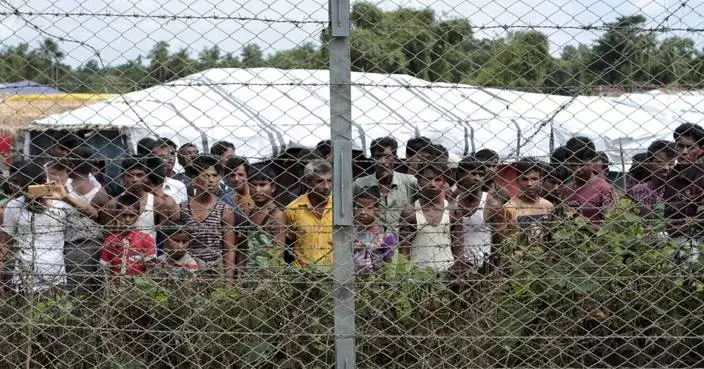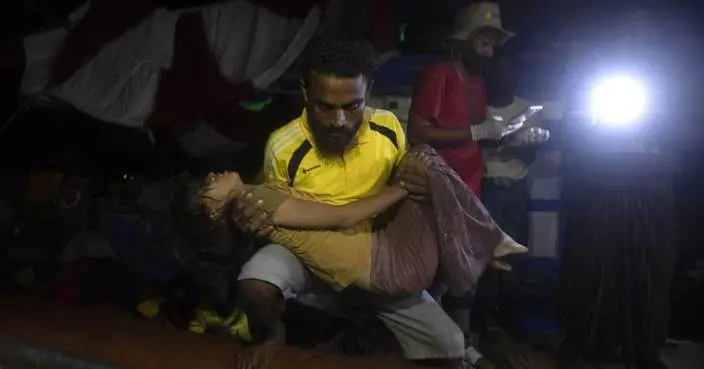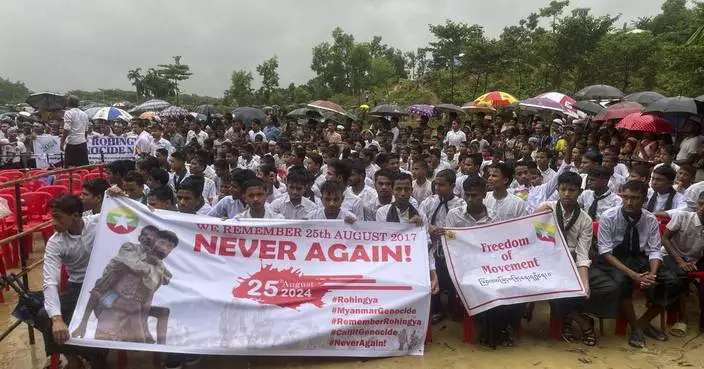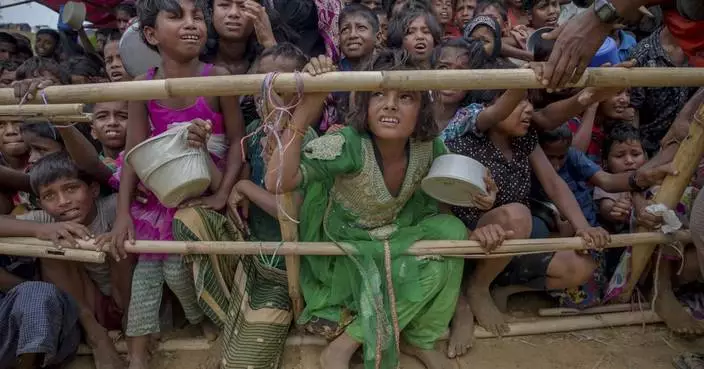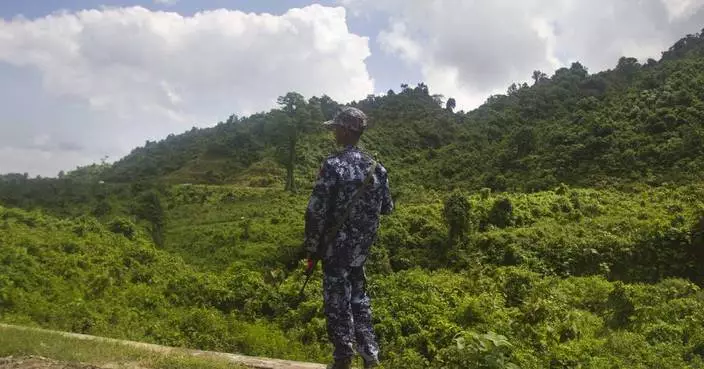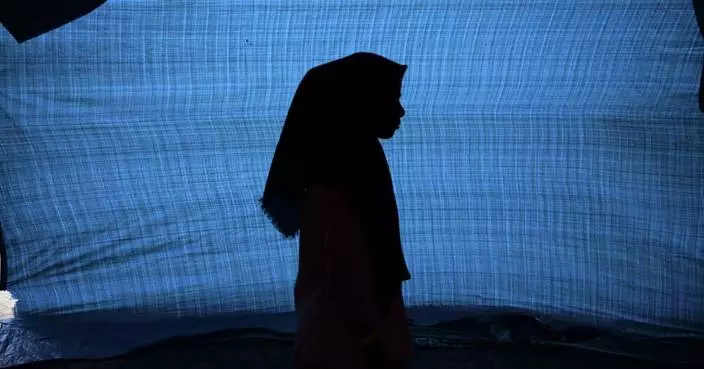Nabi Hussain owes his life to a yellow plastic oil container.
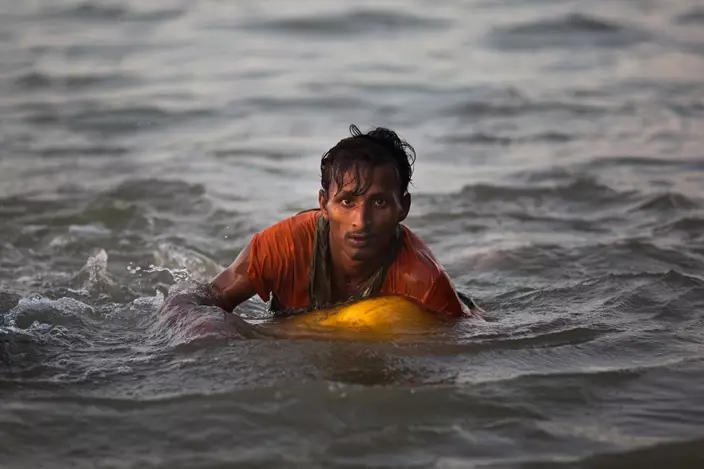
In this Nov. 4, 2017, photo, Rohingya Muslim Abdul Karim, 19, uses a yellow plastic oil container as a flotation device as he swims the Naf river while crossing the Myanmar-Bangladesh border in Shah Porir Dwip, Bangladesh. (AP Photo/Bernat Armangue)
The 13-year-old Rohingya boy couldn't swim, and had never even seen the sea before fleeing his village in Myanmar. But he clung to the empty container and struggled across the water with it for about 2 1/2 miles, all the way to Bangladesh.
Click to Gallery
In this Nov. 5, 2017, photo, newly arrived Rohingya Muslim Aman Ullah, 18, left, Abdul Karim, 19, second left, Mohammed Sadek, 14, third left and Robiul Hassan, 15, right, wait in Shah Porir Dwip, Bangladesh to be transferred to a refugee camp in Cox's Bazar, Bangladesh.(AP Photo/Bernat Armangue)
In this Nov. 4, 2017, photo, Rohingya Muslim Abdul Karim, 19, uses a yellow plastic oil container as a flotation device as he swims the Naf river while crossing the Myanmar-Bangladesh border in Shah Porir Dwip, Bangladesh. (AP Photo/Bernat Armangue)
In this Nov. 4, 2017, photo, Rohingya Muslim Nabi Hussain, 13, poses for a portrait with the yellow plastic drum he used as a flotation device while crossing the Naf river in Shar Porir Dwip, south Cox's Bazar, Bangladesh. (AP Photo/Bernat Armangue)
In this Nov. 4, 2017, photo, Rohingya Muslims use yellow plastic drums as flotation devices as they arrive at Shah Porir Dwip, Bangladesh, after swimming the Naf river. (AP Photo/Bernat Armangue)
In this Nov. 4, 2017, photo, newly arrived Rohingya Muslims with yellow plastic drums they used to aid flotation while crossing the Naf river wait in Shah Porir Dwip to be transferred to a refugee camp in Cox's Bazar, Bangladesh. (AP Photo/Bernat Armangue)
In this Nov. 4, 2017, photo, newly arrived Rohingya Muslims sit with yellow plastic drums they used as a flotation aid while crossing the Naf river, as they wait in Shah Porir Dwip to be transferred on a refugee camp in Cox's Bazar, Bangladesh. (AP Photo/Bernat Armangue)
In this Nov. 4, 2017, photo, from left to right: Rohingya Muslims Belal Hussain, 15; Kamal Hussain, 18; and Robiul Hassan, 15; rest after swimming the Naf river in Shah Porir Dwip, Bangladesh. (AP Photo/Bernat Armangue)
In this Nov. 4, 2017, photo, Rohingya Muslims carrying yellow plastic drums they used as flotation devices walk down the Shah Porir Dwip dock after reaching Bangladesh. (AP Photo/Bernat Armangue)
In this Nov. 4, 2017, photo, Myanmar cattle traders unload cows at Shah Porir Dwip dock, Bangladesh. (AP Photo/Bernat Armangue)
In this Nov. 4, 2017, photo, a Myanmar cattle trader watches Rohingya Muslims swimming with the help of plastic drums across the Naf river and into Bangladesh at Shah Porir Dwip dock. (AP Photo/Bernat Armangue)
In this Nov. 5, 2017, photo, newly arrived Rohingya Muslims carry yellow plastic drums they used as flotation aids and listen to Bangladeshi authorities, not pictured, after swimming across the Naf river at Shah Porir Dwip, Bangladesh. (AP Photo/Bernat Armangue)
In this Nov. 5, 2017, photo, cows walk past a broken wooden boat, previously used by Rohingya Muslims, at Shah Porir Dwip, Bangladesh. (AP Photo/Bernat Armangue)
In this Nov. 4, 2017, photo, three Rohingya Muslims swim the Naf river while crossing the Myanmar-Bangladesh border in Shah Porir Dwip, Bangladesh. (AP Photo/Bernat Armangue)
In this Nov. 5, 2017, photo, newly arrived Rohingya Muslim Aman Ullah, 18, left, Abdul Karim, 19, second left, Mohammed Sadek, 14, third left and Robiul Hassan, 15, right, wait in Shah Porir Dwip, Bangladesh to be transferred to a refugee camp in Cox's Bazar, Bangladesh.(AP Photo/Bernat Armangue)
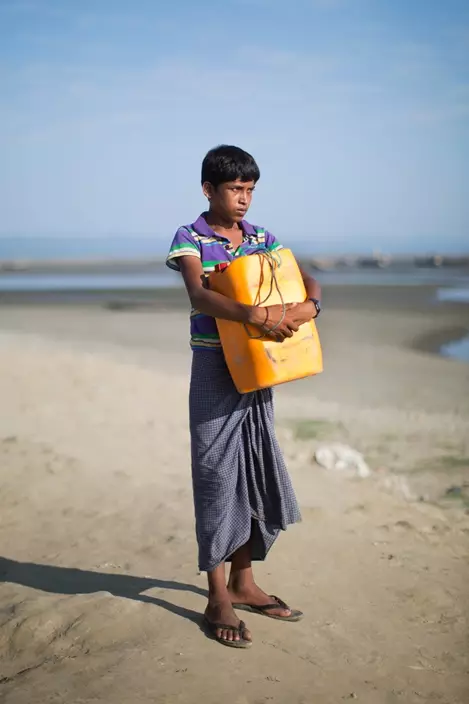
In this Nov. 4, 2017, photo, Rohingya Muslim Nabi Hussain, 13, poses for a portrait with the yellow plastic drum he used as a flotation device while crossing the Naf river in Shar Porir Dwip, south Cox's Bazar, Bangladesh. (AP Photo/Bernat Armangue)
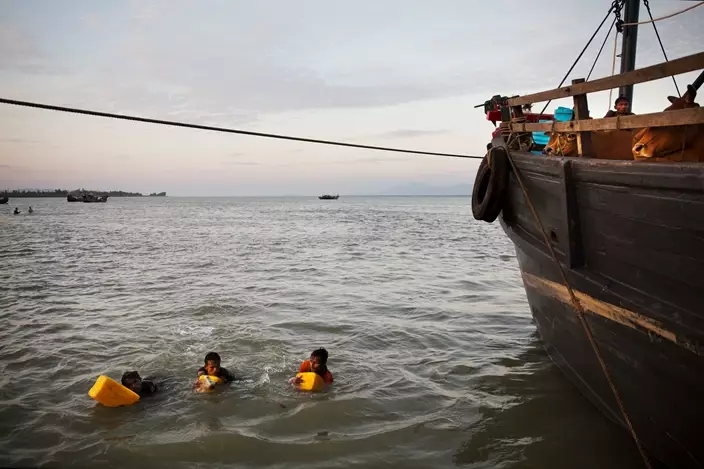
In this Nov. 4, 2017, photo, Rohingya Muslims use yellow plastic drums as flotation devices as they arrive at Shah Porir Dwip, Bangladesh, after swimming the Naf river. (AP Photo/Bernat Armangue)
Rohingya Muslims escaping the violence in their homeland of Myanmar are now so desperate that some are trying to swim to safety in neighboring Bangladesh. In just a week, more than three dozen boys and young men used cooking oil containers like life rafts to swim across the mouth of the Naf River and wash up ashore in Shah Porir Dwip, a fishing town and cattle trade spot.
"I was so scared of dying," said Nabi, a lanky boy in a striped polo shirt and checkered dhoti. "I thought it was going to be my last day."
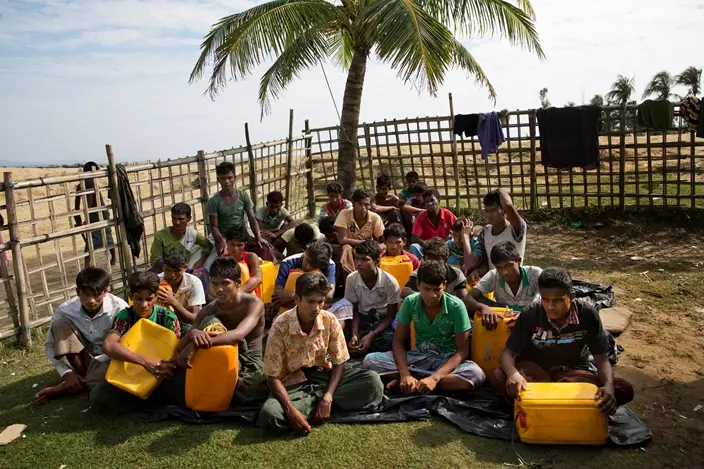
In this Nov. 4, 2017, photo, newly arrived Rohingya Muslims with yellow plastic drums they used to aid flotation while crossing the Naf river wait in Shah Porir Dwip to be transferred to a refugee camp in Cox's Bazar, Bangladesh. (AP Photo/Bernat Armangue)
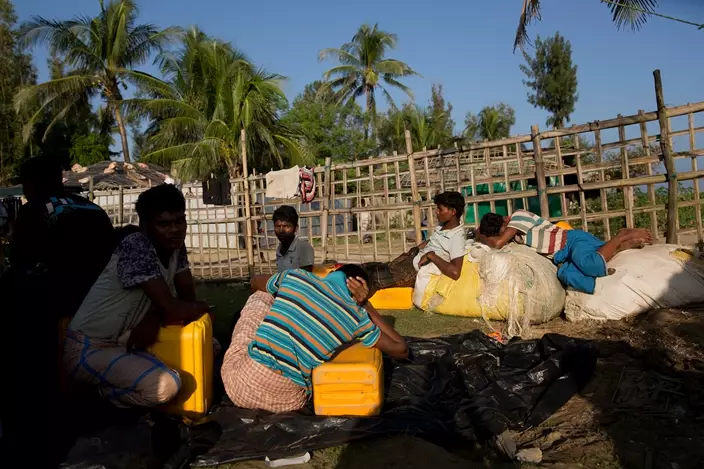
In this Nov. 4, 2017, photo, newly arrived Rohingya Muslims sit with yellow plastic drums they used as a flotation aid while crossing the Naf river, as they wait in Shah Porir Dwip to be transferred on a refugee camp in Cox's Bazar, Bangladesh. (AP Photo/Bernat Armangue)
Although Rohingya Muslims have lived in Myanmar for decades, the country's Buddhist majority still sees them as invaders from Bangladesh. The government denies them basic rights, and the United Nations has called them the most persecuted minority in the world. Just since August, after their homes were torched by Buddhist mobs and soldiers, more than 600,000 Rohingya have risked the trip to Bangladesh.
"We had a lot of suffering, so we thought drowning in the water was a better option," said Kamal Hussain, 18, who also swam to Bangladesh with an oil container.
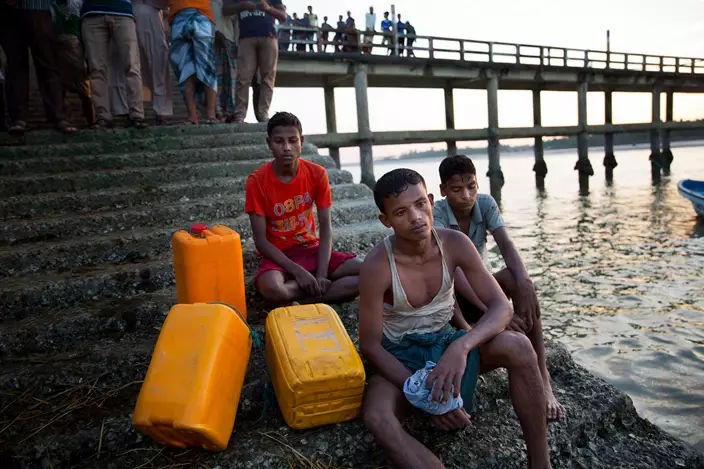
In this Nov. 4, 2017, photo, from left to right: Rohingya Muslims Belal Hussain, 15; Kamal Hussain, 18; and Robiul Hassan, 15; rest after swimming the Naf river in Shah Porir Dwip, Bangladesh. (AP Photo/Bernat Armangue)
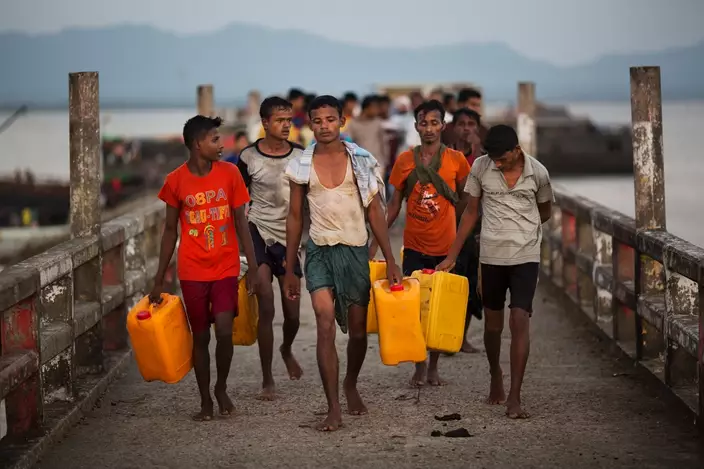
In this Nov. 4, 2017, photo, Rohingya Muslims carrying yellow plastic drums they used as flotation devices walk down the Shah Porir Dwip dock after reaching Bangladesh. (AP Photo/Bernat Armangue)
Nabi knows almost no one in this new country, and his parents back in Myanmar don't know that he is alive. He doesn't smile and rarely maintains eye contact.
Nabi grew up in the mountains of Myanmar, the fourth of nine children of a farmer who grows paan, the betel leaf used as chewing tobacco. He never went to school.
The trouble started two months ago when Rohingya insurgents attacked Myanmar security forces. The Myanmar military responded with a brutal crackdown, killing men, raping women and burning homes and property. The last Nabi saw of his village, all the homes were on fire.
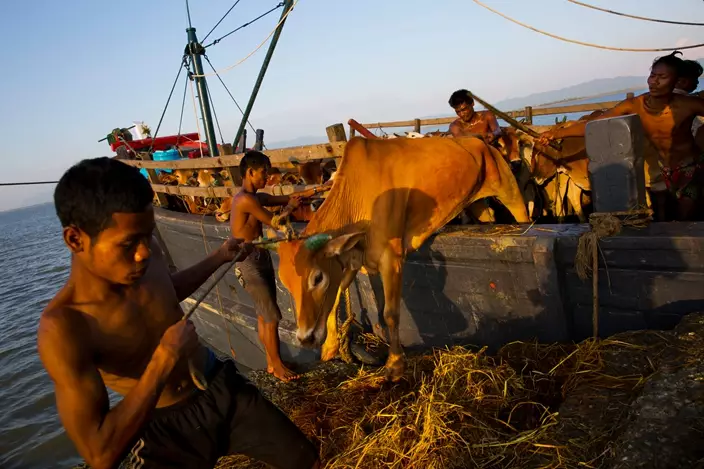
In this Nov. 4, 2017, photo, Myanmar cattle traders unload cows at Shah Porir Dwip dock, Bangladesh. (AP Photo/Bernat Armangue)

In this Nov. 4, 2017, photo, a Myanmar cattle trader watches Rohingya Muslims swimming with the help of plastic drums across the Naf river and into Bangladesh at Shah Porir Dwip dock. (AP Photo/Bernat Armangue)
Nabi's family fled, heading toward the coast, passing dead bodies. But when they arrived at the coast with a flood of other Rohingya refugees, they had no money for a boat and a smuggler.
Every day, there was less food. So after four days, Nabi told his parents he wanted to swim the delta to reach the thin line of land he could see in the distance — Shah Porir Dwip.
His parents didn't want him to go. One of his older brothers had left for Bangladesh two months ago, and they had no idea what had happened to him. They knew the strong currents could carry Nabi into the ocean.

In this Nov. 5, 2017, photo, newly arrived Rohingya Muslims carry yellow plastic drums they used as flotation aids and listen to Bangladeshi authorities, not pictured, after swimming across the Naf river at Shah Porir Dwip, Bangladesh. (AP Photo/Bernat Armangue)
Eventually, though, they agreed, on the condition that he not go alone. So on the afternoon of Nov. 3, Nabi joined a group of 23 other young men, and his family came to see him off.
"Please keep me in your prayers," he told his mother, while everyone around him wept.
Nabi and the others strapped the cooking oil containers to their chests as floats, and stepped into the water just as the current started to shift toward Bangladesh. The men stayed in groups of three, tied together with ropes. Nabi was in the middle, because he was young and didn't know how to swim.
Nabi remembers swallowing water, in part because of the waves and in part to quench his thirst. The water was salty. His legs ached. But he never looked behind him.
Just after sundown, the group reached Shah Porir Dwip, exhausted, hungry and dehydrated.
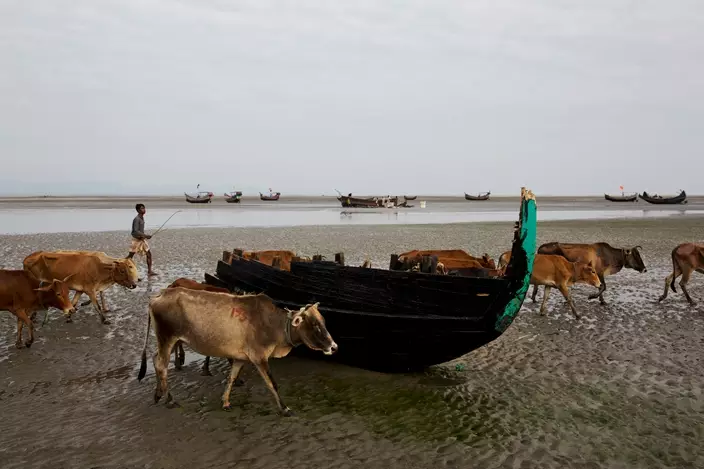
In this Nov. 5, 2017, photo, cows walk past a broken wooden boat, previously used by Rohingya Muslims, at Shah Porir Dwip, Bangladesh. (AP Photo/Bernat Armangue)
Nabi is now alone, one of an estimated 40,000 unaccompanied Rohingya Muslim children living in Bangladesh. He looks down as he speaks, just a few feet from the water, and murmurs his biggest wish:
"I want my parents and peace."
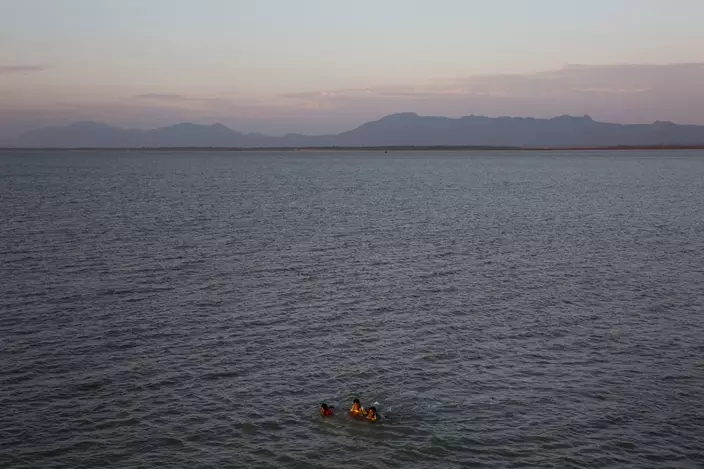
In this Nov. 4, 2017, photo, three Rohingya Muslims swim the Naf river while crossing the Myanmar-Bangladesh border in Shah Porir Dwip, Bangladesh. (AP Photo/Bernat Armangue)
Late afternoon on the next day, authorities spotted a few dots in the middle of the water. It was another group of Rohingya swimming to Bangladesh with yellow plastic containers. They arrived at the same time as a pack of cattle — except that the cows came by boat.

In this Nov. 5, 2017, photo, newly arrived Rohingya Muslim Aman Ullah, 18, left, Abdul Karim, 19, second left, Mohammed Sadek, 14, third left and Robiul Hassan, 15, right, wait in Shah Porir Dwip, Bangladesh to be transferred to a refugee camp in Cox's Bazar, Bangladesh.(AP Photo/Bernat Armangue)
NAIROBI, Kenya (AP) — Caroline Mwikali lost her ability to walk at age 13 after an illness. She quickly learned how difficult it is to get around in Kenya’s busy capital, Nairobi.
Mwikali, who now works at a car financing company, said public transport is not designed to accommodate wheelchair users like her.
Nairobi's most popular modes of transport include motorbikes along with minivans and minibuses that are not fitted with ramps. They also are not designed to fit wheelchairs in their aisles, so users must be hoisted up the stairs and placed on regular seats while their wheelchairs are put with luggage.
“In most cases, the people manning the bus terminals have to lift you off the wheelchair to help you board the buses. This is not only uncomfortable but leaves you attracting unnecessary attention from the public,” Mwikali told The Associated Press.
She is among 2.2% of Kenya’s population, or about 900,000 people, who live with a disability. The most common type of disability is mobility-related at 42%.
One entrepreneur, Daniel Gatura, founded Ace Mobility in Nairobi in 2021. Its vehicles are modified with ramps and swivel seats to accommodate people with disabilities and anyone else who needs support commuting.
Gatura said he was inspired by a personal experience growing up.
“My father sustained a spinal cord injury in an accident that left him in a wheelchair when he was just 5 years old. I witnessed the challenges my father faced, including losing his job due to transportation issues,” Gatura said.
Users can book rides through the Ace Mobility app. Drivers are trained as caregivers, ensuring they understand how to provide respectful and appropriate assistance to passengers with disabilities.
Gatura said they have 5,000 users.
“We are changing the narrative around disability and reduced mobility. Just because you have a disability doesn’t mean you cannot earn for yourself; it doesn’t mean you are a nobody in the society,” he said.
The transport is more expensive than public transport, charging the equivalent of $1 per kilometer (0.6 miles). The same amount can be used to pay for a 40-kilometer (24-mile) ride in public transport vehicles. But Gatura noted it delivers people directly to their homes.
“I find the charges quite fair considering the convenience that it offers. I get to travel comfortably and without necessarily moving from my chair. It also somehow preserves my dignity,” said Mwikali, who has used the service for four months after a referral from a former classmate.
But others like Cindy Cherotich can't afford the service. She must jostle for space on minibuses while on crutches.
“When I go to the bus station sometimes the public vehicles do not allow me to board," she said. “When they see my crutch and (see) somebody who is OK without crutches, they will let them in and I will be left.”
Lucy Nkatha, a disability advocate and coordinator of Kiengu Women Challenged to Challenge Group, an NGO, said she had never heard of Ace Mobility and called for marketing support for such companies.
“It should also be made affordable,” she said.
Sandra Nyawira, the disability inclusion adviser at United Disabled Persons of Kenya, noted that Kenya has a number of policies in place to address accommodations for people with disabilities, but implementation is rare. She called for more political will.
“It’s one thing to have a policy that speaks to your issues, but then it’s another to implement them,” she said.
The Associated Press receives financial support for global health and development coverage in Africa from the Gates Foundation. The AP is solely responsible for all content. Find AP’s standards for working with philanthropies, a list of supporters and funded coverage areas at AP.org.
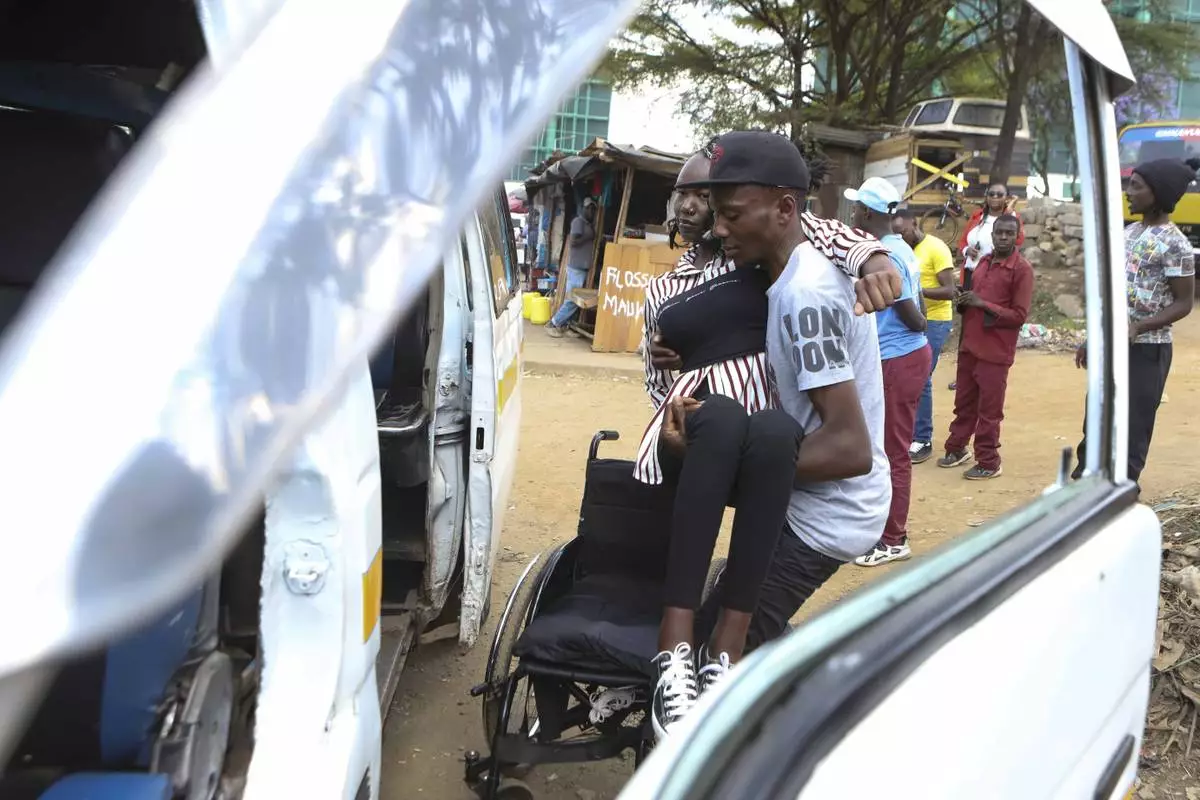
A man helps Carol Mwikali to get inside a public transport vehicle in Nairobi, Kenya, Wednesday, Oct. 9, 2024. (AP Photo/Andrew Kasuku)
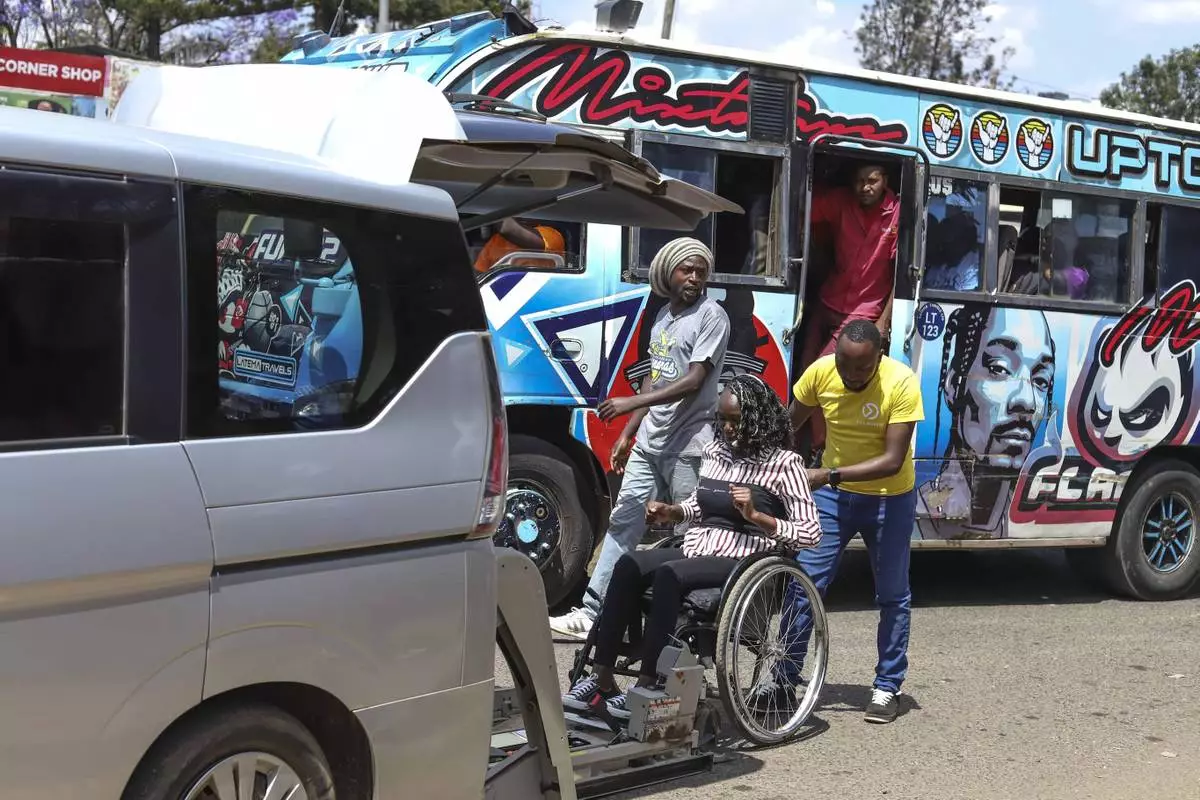
Daniel Gatura, Co-founder of Ace Mobility company, helps Carol Mwikali to get inside an Ace Mobility vehicle in Nairobi, Kenya, Wednesday, Oct. 9, 2024. (AP Photo/Andrew Kasuku)

Carol Mwikali sits inside an Ace Mobility company vehicle in Nairobi, Kenya, Wednesday, Oct. 9, 2024. (AP Photo/Andrew Kasuku)

Carol Mwikali rides around on a wheelchair in Nairobi, Kenya, Wednesday, Oct. 9, 2024. (AP Photo/Andrew Kasuku)

Daniel Gatura, Co-founder of Ace Mobility company, helps Carol Mwikali to get inside Ace Mobility vehicle in Nairobi, Kenya Wednesday, Oct. 9, 2024. (AP Photo/Andrew Kasuku)
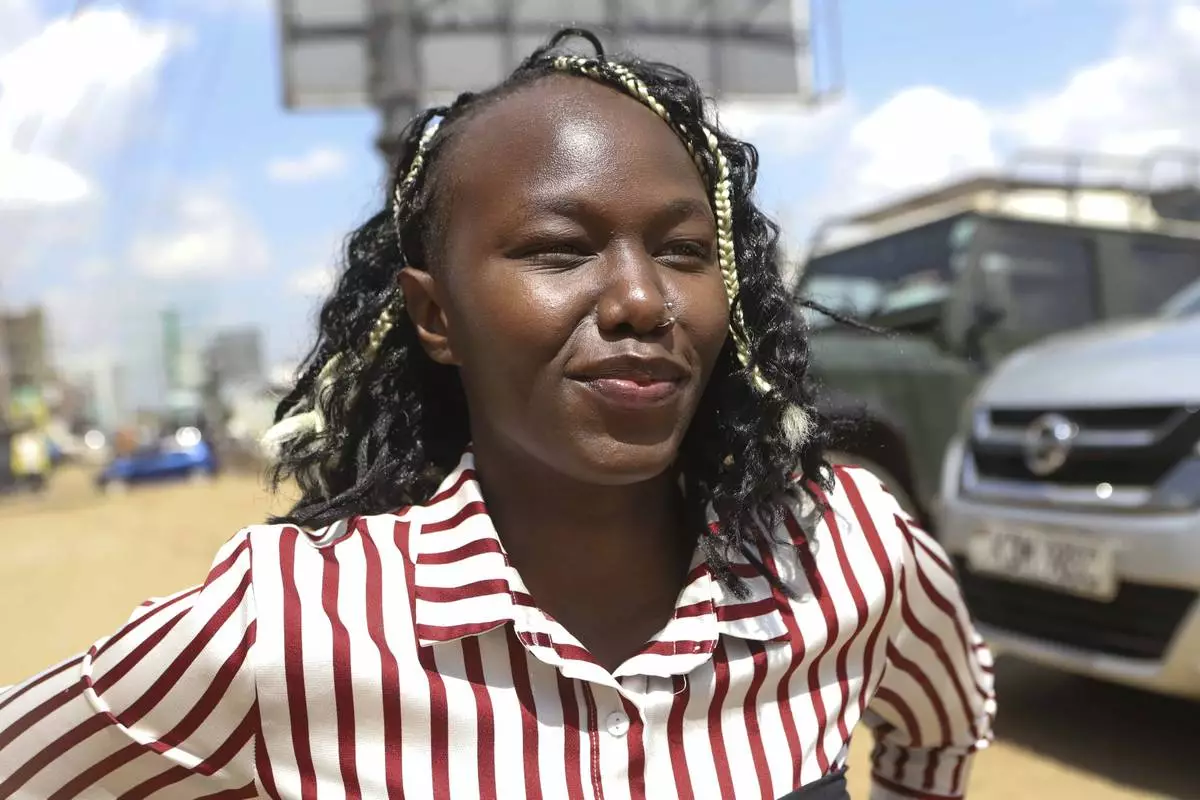
Carol Mwikali, who uses a wheelchair, poses for a photo during an interview with Associated Press in Nairobi, Kenya, Wednesday, Oct. 9, 2024. (AP Photo/Brian Inganga)





















